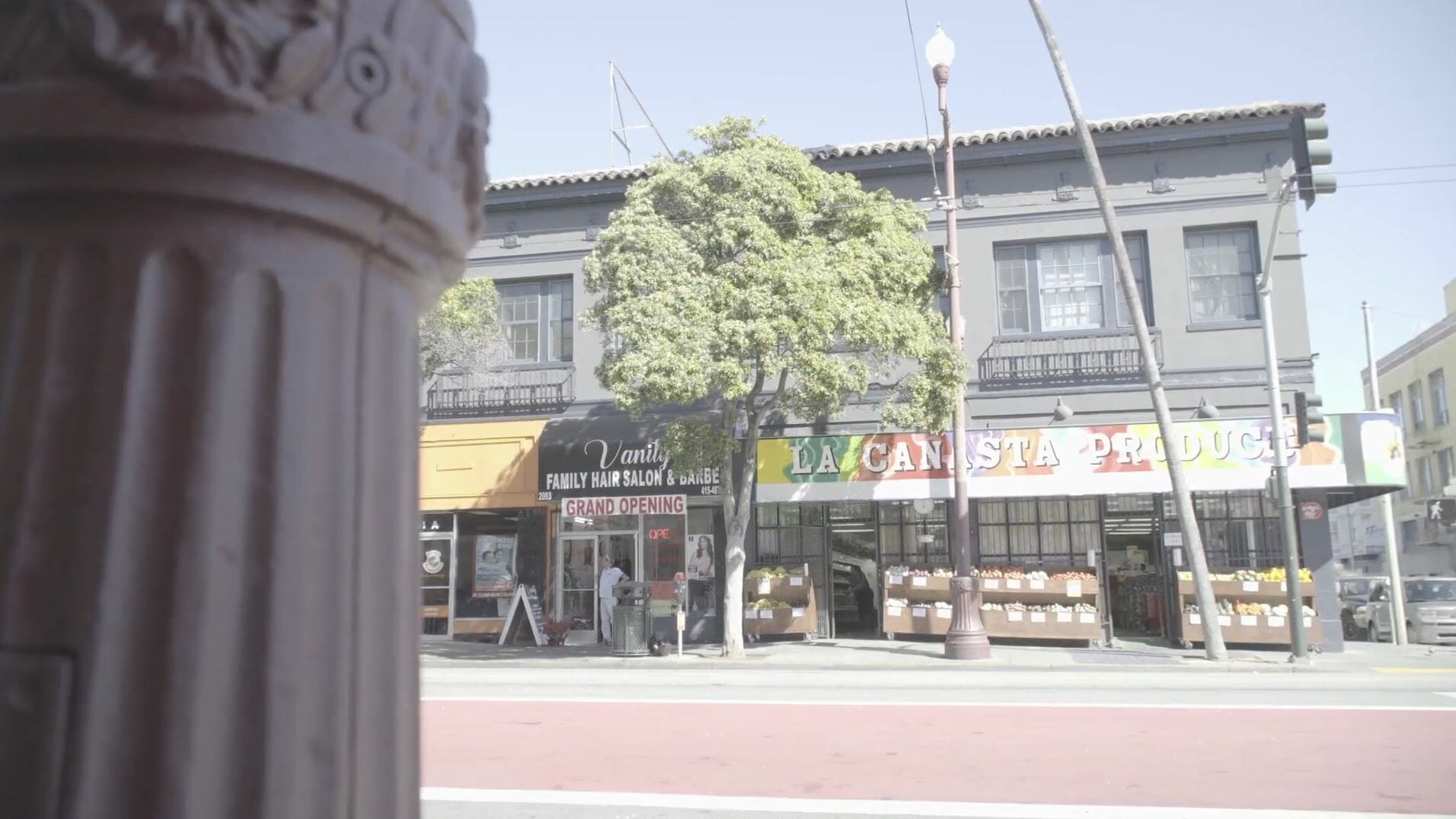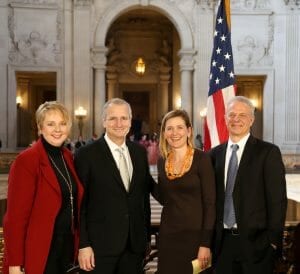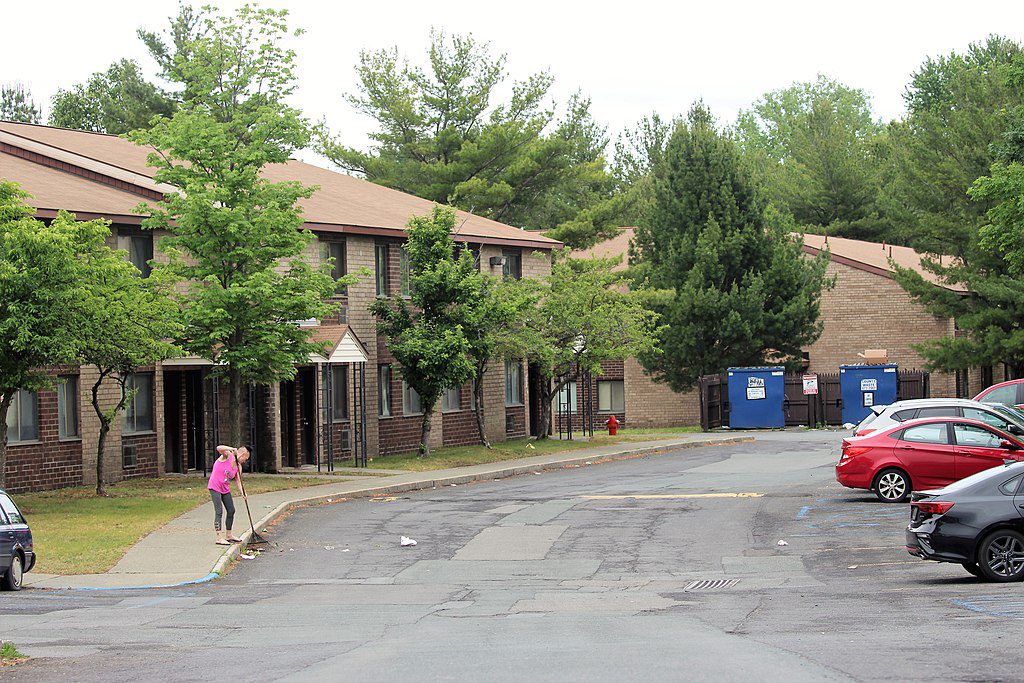
2093 Mission Street in San Francisco. Photo courtesy of Citi

From left, Vicki Joseph, Northern California market manager for Citi Community Development; Bob Annibale, Citi’s global director of community development inclusive finance; Rebecca Foster of the San Francisco Housing Accelerator Fund (SFHAF); and Rich Gross of Enterprise Community Partners and SFHAF board president.
The San Francisco Housing Accelerator Fund, which aims to to preserve or develop 1,500 affordable housing units in five years, officially launched in 2017. How is the fund working out so far? What level of affordability is it taking on? How has it sidestepped challenges? Shelterforce editor Miriam Axel-Lute and associate editor Keli Tianga recently chatted with Bob Annibale, Citi Community Development’s global director of community development inclusive finance, and Rebecca Foster of the San Francisco Housing Accelerator Fund to learn more.
Miriam Axel-Lute: What was it about this particular fund that prompted Citi to get involved at such a key level?
Bob Annibale: San Francisco simply needs more affordable housing, and [to] secure affordable housing that already exists, and quickly. Mayor Ed Lee, at the time, made the case very directly to us about the need to establish a housing accelerator fund.
That’s really what drew us at first to look at this vehicle. We had the right partners—the city itself, strong affordable housing developers—and a very, very strong need for preserving affordability.
Axel-Lute: Rebecca, what do you look for in a development and in a developer, in terms of track record and balance sheet, when you’re deciding who to partner with with this fund?
Rebecca Foster: We were created through the Mayor’s Housing Working Group and public and private stakeholders to take more risk than the city or fully private banks can take. Generally, we do that in terms of being able to offer higher loan-to-value loans, to take larger concentration with a single developer, or to just do larger deals in a single transaction.
That being said, we are a hard debt lender, and we have investors, Citi being the largest of them, and it’s absolutely essential for our long-term sustainability that we are doing very solid underwriting of our borrowers. We take strategic risk where it meets the need, but we definitely do need to have developer partners who have a solid track record—they’ve done affordable housing transactions before; they have the balance sheet to be able to pay back a portion of our loan along with the property value, should we need to, in a worst-case scenario, to take that property back and to find another partner for it.
That being said, one of the things we’re also working on, along with a number of partners and the developer community, is how we can get more developers around different communities in San Francisco and more community organizations to be able to work together so that more of them are able to do this kind of work, or that this work is able to be done in more neighborhoods, because we certainly don’t want to not be preserving buildings, for example, in certain neighborhoods because there isn’t a developer there who has the kind of track record that makes them investable.
Axel-Lute: What’s the sweet spot for the properties that you’re looking to preserve? What level of affordability are you taking on?
Foster: The main product that we lend around right now is a bridge loan to permanent capital from the city of San Francisco. And so, our loans really allow developers to compete in a very competitive market, to get site control, and to be able to quickly do the rehab or add the accessory dwelling units to a property in 12 to 36 months, before the permanent subsidy that’s required to ensure that long-term affordability can come in from other public sources.
With that in mind, what we’re really focused on is being able to help developers get either land or properties where that permanent capital source is going to be able to come in. And so, our affordability priorities are really focused around what those public priorities are for that permanent capital. On average for buying existing buildings, our goal is the city’s goal, that those will average over time to 80 percent of median income across the building.
That allows for lower-income tenants, maybe an elderly individual receiving Social Security and is at 10 to 20 percent of median income, [to] be cross-subsidized by another tenant in that building who maybe is earning 100 percent of median income, which in San Francisco is still not enough, even close to enough, to afford market rent.
So the goal is over time they get to that 80 percent of median income. We are also working on homeless housing projects, for example, where the average median income is significantly lower, but there are other public sources over the long-term that will subsidize those rent levels.
Keli Tianga: In an article in Next City, you are quoted as saying that in a property you were considering acquiring, there had to be evidence that tenants are already organizing or would be willing to organize against new owners who would evict them, and that tenant buy-in makes a difference.
How do you know that kind of energy exists within a given property, and why is this important to the Housing Accelerator Fund?
Foster: The developers who we are lending to are very entrenched community organizations. We’ve done five loans with MEDA, the Mission Economic Development Agency, and they are very active with all sorts of different programs, from financial empowerment to education funding and anti-displacement work around real estate in the Mission. They have been doing this work for long enough that people come to them when their building, or their neighbor’s building, or their relative’s building, is on the market or when a landlord has been harassing tenants in anticipation of trying to sell their building, for example.
We’re also working on two loans right now with the Chinatown CDC and, similarly, they are very active in their community and do the work on a specific building to understand themselves [whether] the tenants [have] bought into this purchase.
We require that they provide evidence to us of those conversations with the tenants, and that the tenants understand that when MEDA or Chinatown CDC purchases this building with a loan from us, that the building is transitioning from rent-control and the private market to being owned by a nonprofit and, by virtue of our loan and then the city’s loan that takes out our loan, instead of rent being set by the private market within the regulatory framework of rent control, that rents are permanently restricted based on income level.
That’s a really big shift for tenants, and we want to make sure that everyone’s bought into that shift, because there may be a sense for some tenants, well, maybe I’m better off under rent control. Generally for these tenants, they are experiencing harassment [and/or] eviction notices that push to displace them. The challenge with rent control, while it’s a really powerful tool in San Francisco in many ways for preserving affordability, is that in the hot real estate market like this, rents are so low for tenants who’ve been there for a long time that the landlords are incredibly incented to do anything they can to get those low-paying tenants out of there. And those are exactly the longtime residents that we are hoping to be able to keep and give them the opportunity to stay in the place that they’ve lived for decades.
By making this transition to permanent affordability, those units will no longer be at risk of resetting to those market-rate rent levels which, in some cases, could be from a $300 a month rent to a $4,000 a month rent, not only displacing that tenant, but also making that unit no longer affordable to the next person who comes in to rent it.
Axel-Lute: In some cases like that, though, the rent will go up, because probably you’re not keeping them at $300 a month, unless they’re extremely low-income.
Foster: Yes. The goal is that no one will ever pay more than 20 percent to 25 percent of their income in rent. The city would not want anyone to be rent-burdened. However, if someone in a 15-unit building is actually earning $200,000 a year and they are paying $800 a month in rent, and based on their income level, they could be paying $1,200 a month in rent, then there will be a rent increase to get them to that 20 percent of their income level in rent payment.
It’s really important that [those conversations] happen before the building is purchased, and before this transition occurs, because for some higher-income individuals in the building, their rent over time could go up. Generally, when that’s been the case, [tenants] having that stability, knowing that they would not be at risk for eviction, getting to know who the new landlord would be [helps them] to not feel like, well, this is going to mean that I will be displaced from the city where I live and work.
MEDA or Chinatown CDC would not be borrowing from us to buy a building where 80 percent of the tenants were earning $100,000. That’s not their focus.
Annibale: One of the reasons this appealed to us, too, is the partners working on it so far, people like MEDA, Chinatown CDC, Mission Housing, BRIDGE Housing. They are the ideal intermediaries to ensure this transition is a smooth one. That really gave us a lot of comfort. We needed a vehicle that could be nimble and act quickly and decisively. The working relationship between the fund and the city is so close, that that’s very important.
Axel-Lute: Since you mentioned being “nimble,” we were curious about the balance between needing to be nimble and quick in the kind of market that you’re in, but also do the due diligence and the vetting that these projects need. How do you balance that?
Foster: Yes, that’s a constant challenge, and really a very important one operationally for us. As much as possible, we front-load, so a piece of that vetting is actually about the organization itself and their ability, their strength financially, their strength in the community, their track record with development. So we do the work on the organization ahead of time, and then have a very focused process to move incredibly quickly once they are in contract for a transaction.
We can close in 60 days, which is significantly faster than the city is able to close, and very competitive with what any other lender could do working all-hands-on-deck. It requires a lot from our borrowers. It’s having a process that everyone is on board with from day one in terms of inspections and construction reviews. It’s really just in the nitty-gritty details. We have been building up over the course of the last six loans to make sure that anything that could be a bottleneck, we start parallel-tracking earlier.
The other thing that makes it possible is working with borrowers like MEDA and Chinatown CDC who have done these types of transactions before. They understand what pieces take longer. Working with the tenants takes longer, generally, and so they will start working with the tenants when they’re looking at a building, because they have those tenant relationships. They will start doing some of that work to understand how bought in the tenants are and have those conversations with them before they actually get into contract on a property so that we can really focus in the 60 days on getting the environmental diligence done, looking at the financials. And it is still very tight.
This is different from how the borrowers and how the city have been used to doing things. And it’s particularly become clear that it is really important for these smaller sites. A big parking lot that costs $8 million that you could put 200-plus units of housing on, that is probably going to be a patient seller, because they’re not going to have 30 buyers lined up for that site, but a 5-, 10-unit building in the Mission, for better or worse in this market, you could have a foreign buyer. You could have an on-the-side investor in local apartment buildings. You could have apartment building portfolio holder. You could easily have 10 to 12 actively interested buyers, many of whom might be able to be all-cash, competing for a property like that.
It’s really pushed the affordable housing developer community and us and the city. This isn’t business as usual for the affordable housing developer community. We can’t draw out a transaction for six months and still get the deal. We have to be able to move more quickly. So, everyone is really all in to figure out how we can do it. It’s a big piece of why we exist.
Tianga: We’ve had a couple of pieces written recently about the increasing unaffordability of commercial spaces, especially for small, independently owned businesses. You have funded a few commercial spaces. Was this just happenstance because of the property as a whole, or is it part of a strategy?
Foster: This has been an evolving part of the [city’s] small site program. The city has been very thoughtful and creative around the entire program, and this is one example of that. The Mayor’s Office of Housing and community development, really their funds are focused on housing. However, many of these small site properties do have ground floor commercial and retail. And instead of drawing a line and saying we’re not going to include those in our underwriting, what they started with is, OK, if the commercial is less than 50 percent of the building, we can finance the commercial as well.
Organizations like MEDA are really focused more broadly on stabilizing the community, housing being one tool for doing that. But, as you’ve said, businesses are getting displaced, too, and a lot of these businesses are the places of employment for the residents and a critical part to a healthy community.
The city being flexible has allowed an organization that’s borrowing from us, like MEDA, [to] have a bigger impact by also preserving commercial space.
One of the loans that we did in January to MEDA is on 17th Street and Mission, a key artery in the Mission. It has a La Canasta market on the ground floor, [and] a total of five commercial spaces. The revenue from the commercial is about 50 percent of the revenue from the building.
It took a different focus from us, from an underwriting perspective, but preserving that, we all understand, is a critical piece of the broader mission of anti-displacement and anchoring a community in a place like the Mission.
Axel-Lute: An article in Housing Wire was asserting that apartments are actually over-built in the urban core right now, even though it acknowledged that affordable units were still lacking. I was wondering if you thought that applied to San Francisco?
Annibale: The median single-family home in San Francisco is at $1.61 million in the first quarter. So, if there is over-development, we haven’t seen it yet in the pricing. It’s the second densest city in the United States, so there is a limitation, and we know in many areas for zoning and planning reasons, there’s still a height limitation on the number of total new units. [There were] 123,000 new jobs between 2009 and 2015, an increase of 22 percent, but only 11,000 new housing units.
So, I think you still have people who may not opt in for those top-end houses, but then they’re going further deeper into the housing market and paying for housing that they may not have aspired to. You also see an exodus happening. San Francisco risks losing people, because for their cost of living, even [people in] these new good jobs are finding it very expensive.
I think that’s a very unusual situation that San Francisco has. [High levels of] job creation and investment, but otherwise it looks like it’s suffering. We’re finding that people are living further and further from the city, and it’s changing the whole social dynamic of the Bay.
Foster: Yes, I totally agree. Even if luxury markets soften a bit, that then can even further impact the demand for the type of housing that we’re focused on.
Part of the rationale for the creation of the Housing Accelerator Fund is that many of the revenue sources and tools that the city has to support the production and preservation of affordable housing are very cyclical, tied to market-rate developer fees. In a good economy, the city has more money to put into affordable housing. So, in some ways we’d be so lucky to have a little bit more of a softening in real estate prices in San Francisco. Unfortunately, what the city’s been challenged with in the past is they don’t have the capital at downturn to actually be able to, at a lower cost, buy up some sites for the future pipeline.
One of the goals in creating this fund with other capital is that if that might happen in two or three years, and we are well-capitalized enough to be able to buy those parking lots when they’re selling for $6 million instead of $11 million, then we’ll be more ready for the next cycle.
Axel-Lute: That’s great, because I’ve heard so many people in the Bay area say “I wish we’d bought land in the last downturn.”
Annibale: There’s very little land in a peninsula. That’s the challenge, isn’t it? There’s only so much land.
Axel-Lute: There’ve been some attempts to put together funds like this before that to some extent faced the kind of bureaucracy and delays that they were designed to circumvent. Is there anything in particular about how this fund was put together that enabled you to sidestep those challenges and really be as quick on the draw as you need to be?
Foster: A huge piece of this, honestly, in our creation was having a startup capital partner in Citi who basically said, “You know what? Before you have $5 million in foundation mez[zaine] debt, before you have senior capital from a bank, we are going to put in the couple hundred thousand dollars necessary for you to build something that is really going to work.”
This came out as a flashy idea from the Mayor’s Housing Working Group, but the nuts and bolts of creating an independent 501(c)(3) with the right balance sheet structure and the right governance structure and the right business plan is not fast, just like anyone starting a nonprofit could certainly tell you. In the political world, you need to have dry powder in the form of capital for those startup costs, which Citi provided. [We] also [had] the buy-in from the former director and the current director of the Mayor’s Office of Housing, as well as Mayor Lee say[ing], “OK, this might take a year and a half to build this right, and we’re not going to move on to the next thing, because we think it’s important.” That was a really key piece.
A key tenet of how we tweak the loans we’re offering and how we think about new products is “Where is there a problem in the market in terms of delivering affordable housing faster and more cost-effectively, and how can we specifically play our role in solving that problem?” Figuring that out is the only way we have a product that meets a need and that there’s demand for, and that takes working really closely with the developers and the borrower community in a way that sometimes it’s hard for a government who’s a little more at arm’s length with those organizations to do.
That’s a huge part of my role, having those close relationships and really being on the ground and figuring out what are the specific nitty-gritty problems. You want to put accessory dwelling units into these buildings so that that long-term cash flow works better, but the city’s not ready to take that risk because the legislation is brand-new? Okay, we need to figure out how to finance it and get our investors comfortable with that.
Having partners both in the Mayor’s Office of Housing and in the developer community who trust us say, OK, let’s roll up our sleeves and solve these problems together. This isn’t political. This is nuts and bolts of getting things done.
Annibale: [The mayor] referred to Citi as his angel investor. While $500,000 initially is not as sexy when it’s doing legal and accounting and filing and financial advisor costs, it’s the capital that takes the concept to at least the legal vehicle stage. And last year we put another $250,000 into accelerating and supporting Rebecca’s team staffing.
I think the idea of a one-stop, citywide nonprofit fund that could be dynamic and nimble, close to both the city and the nonprofit developers, appealed to us a lot as an investor.
Tianga: Bob, in your work traveling internationally with Citi, have you seen any similar international models?
Annibale: Internationally, we see more models of funds that are just basically an aggregator. In the United States, we were very much trying to embrace the idea of accelerators and aggregators, models that help take us to scale around affordable housing investments.
We looked at a couple other examples you know well, for example, Grounded Solutions—How do you accelerate and scale further community land trusts?—and Joint Ownership Entity in New York—something like 10 community development corporations coming together in aggregate to create and preserve a large stock of affordable housing. We were a $1 million angel investor in JOE. We put $1 million as a first investor, again, at National Mortgage Collaborative, with Springboard [CDFI]. They’re platforms for aggregation, and that allows the standardization, a platform to help scale.
For those who want to finance this sector, it’s incredibly helpful to have organizations and vehicles like these.
In addition to the capital we put in [to SFHAF], one of the early investors was Citi Community Capital. We put $20 million in financing through the fund. I don’t know that we’ve announced it otherwise, but we’ve doubled that now to $40 million in financing, because we think this fund is exactly what San Francisco needed. It’s been a very fruitful investment. I think this is going to pay off for the city of San Francisco.
Tianga: Where do you see the fund going over the next five years? And do you know of other cities that are trying to replicate this model?
Annibale: Hopefully we’ll get others to come in with capital support, as well as financing. We’ve been working with Enterprise, looking at a model for a regional housing accelerator fund. Each city may not be able to lead one on their own, and that would leverage a lot of the learning from the San Francisco accelerator fund.
Foster: We launched with our first investment capital about a year ago, and before the end of our fiscal year in June, we’ll have financed about 300 units. When we launched, we said our goal over the first five years was to be a well-capitalized and sustainable fund looking out into the future, and to have financed 1,000 units of affordable housing. We have grown so much faster than any of us expected in our startup year, already completed six loans, and we’re working on three more right now, with what looks like a only steeper acceleration of acquisitions.
A few areas that we’re focused on specifically in addition to the small sites work [are] the preservation of larger buildings—we’re working on a loan right now for a 70-plus unit building in Chinatown. That will be an $11 million loan. I think that will get us closer to what Kate Hartley, the director of the Mayor’s Office of Housing, says is a goal of increasing our social housing stock in San Francisco.
We’re also spending a lot of time on homeless housing and how we can support developers in building housing at a lower cost and new construction much faster. Right now, it takes seven years often, between buying a parking lot, for example, and having new units of housing available for formerly homeless individuals, or affordable housing for families. It takes way too long.
We can’t address all those problems, but we are working on problem-solving. If we can bring the upfront capital and get around some of those things and be a creative partner so that can be three years, and instead of $600,000 a unit, can be $350,000 a unit, that would be a huge win.
Where can a creative-thinking capital partner plug in to address some problems, and really in some ways be able to prototype something [for] the public sector? We can give them a little bit of cover, and time for them to then scale what we can do, or what we model.
That’s definitely the case with the accessory dwelling units (ADU). The city doesn’t finance putting ADUs into these buildings right now because it’s new, but we have financed four so far, and have more in the pipeline, and are documenting all the lessons learned from that and sharing that process with the city so that, hopefully next year, they can start financing ADUs in their portfolio directly.
Annibale: [We want] to make sure that the capacity of the affordable housing developers and those who want the access the fund is there, because they too sometimes need support to get the right staffing and the right legal and other documentation support so that they can be a part of accessing the fund. That’s one part of the priorities.
Foster: We have fielded a lot of calls from other cities that are interested in doing something similar and facing similar challenges. Fresno, Berkeley, the city where Walmart is headquartered—Bentonville, Arkansas. Cities all over the country. It is going to be a little bit different in every city.
Annibale: We think there’ll be lots of spin-offs from this and chances to be able to replicate a lot faster in other cities, learning from San Francisco.
Thank you.





Comments